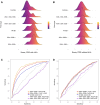A high polygenic risk score is associated with SSA/SSB antibody positivity and early onset in primary Sjögren's disease
- PMID: 39693120
- PMCID: PMC12212914
- DOI: 10.1093/rheumatology/keae693
A high polygenic risk score is associated with SSA/SSB antibody positivity and early onset in primary Sjögren's disease
Abstract
Objectives: To calculate a polygenic risk score (PRS) based on single nucleotide variants (SNVs) previously associated with primary Sjögren's disease (SjD) with genome-wide significance and determine the genetic risk for SjD stratified by antibodies, sex and age at diagnosis.
Methods: Patients with SjD (n = 1065) were genotyped using Illumina OmniExpressExome chip. Control genotype data were available (n = 7742). Two PRSs were constructed, one including HLA gene variants (n = 21 SNVs), and one without HLA (n = 18 SNVs). High PRS quartile (Q4) individuals were compared with low PRS (Q1-3).
Results: A high PRS was associated with SSA antibody-positive SjD (OR 9.16, 95% CI 7.75-10.85, P = 3.7 × 10-146), and strengthened in SjD positive for both SSA/SSB antibodies (OR 13.67, 95% CI 10.88-17.32, P = 4.6 × 10-108). High PRS classified SSA/SSB antibody-positive SjD with very good accuracy (AUC 0.86). PRS without HLA showed a weaker association with SSA/SSB positive SjD (OR 2.09, 95% CI 1.71-2.55, P = 6.4 × 10-13). Antibody negative SjD displayed a PRS similar to controls. Patients in the high PRS quartile were significantly younger at diagnosis, 48.9 ± 14.9 vs 53.4 ± 13.4 years in the low PRS quartiles (Q1-3), P = 2.2 × 10-6, and presented higher frequencies of ANA, SSA and SSA/SSB antibodies, P < 1 × 10-5.
Conclusion: A high PRS is associated with SSA/SSB antibody positivity and early disease onset, both largely attributed to the weight of the HLA alleles. Integration of PRS with other biomarkers applied to clinical phenotypes could be a useful tool for disease risk stratification and treatment decisions.
Keywords: HLA; SSA; SSB; Sjögren’s disease; antinuclear antibodies; genome-wide association studies (GWAS); polygenic risk score (PRS); single nucleotide variant (SNV).
© The Author(s) 2024. Published by Oxford University Press on behalf of the British Society for Rheumatology.
Figures


References
-
- Retamozo S, Acar-Denizli N, Horvath IF et al. ; Sjögren Big Data Consortium. Influence of the age at diagnosis in the disease expression of primary Sjogren syndrome. Analysis of 12,753 patients from the Sjogren Big Data Consortium. Clin Exp Rheumatol 2021;39(Suppl 133):166–74. - PubMed
-
- Theander E, Jonsson R, Sjostrom B et al. Prediction of Sjogren’s syndrome years before diagnosis and identification of patients with early onset and severe disease course by autoantibody profiling. Arthritis Rheumatol 2015;67:2427–36. - PubMed
MeSH terms
Substances
Grants and funding
- KAW 2014.0272/K&A Wallenberg Foundation
- 2018-05973/Swedish Research Council
- WT090532/WT_/Wellcome Trust/United Kingdom
- National Genomics Infrastructure
- SNP&SEQ Technology Platform in Uppsala
- King Gustaf V's 80-year Foundation
- WT064890/WT_/Wellcome Trust/United Kingdom
- WT098017/WT_/Wellcome Trust/United Kingdom
- The Swedish Heart-Lung Foundation
- Norwegian Research Council
- Knut and Alice Wallenberg Foundation
- Swedish Rheumatism Association
- Brunnberg foundation, Uppsala University
- Swedish National Infrastructure for Computing
- K&A Wallenberg Foundation
- WT_/Wellcome Trust/United Kingdom
- Swedish Research Council
- VR#2021-02503/Swedish Research Council
- Uppsala Multidisciplinary Center for Advanced Computational Science
- Stockholm County Council
- Agnes and Mac Rudberg foundation
- VR #2022-00637/Swedish Research Council
- Science for Life Laboratory. Resources
LinkOut - more resources
Full Text Sources
Medical
Research Materials

